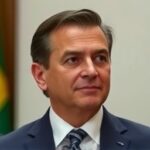In a dramatic escalation of the ongoing conflict, Russia launched a barrage of more than 100 drones alongside a ballistic missile strike on Ukraine early Friday, just as the United States intensified diplomatic pressure on Kyiv to accept a contentious peace plan that includes significant territorial concessions. The attack, which targeted energy infrastructure and civilian areas, has left at least 12 people dead and dozens injured, underscoring the fragility of any potential negotiations amid unrelenting violence.
The US peace plan, reportedly drafted in secret consultations between Washington and Moscow, demands that Ukraine cede control over parts of Donetsk and Luhansk regions while scaling back its military capabilities, including limits on NATO-aligned weaponry. Ukrainian President Volodymyr Zelenskyy has publicly decried the proposal as a “surrender disguised as diplomacy,” vowing to resist what he calls an imposition of Russian demands. This development comes at a pivotal moment, with European leaders voicing alarm over their exclusion from the talks and convening emergency summits to forge a unified stance.
US Peace Plan Demands Territorial Handover and Military Caps
The core of the US peace plan revolves around a framework that would formalize Russia’s de facto control over annexed territories, a move critics argue rewards aggression. According to leaked documents obtained by Western media outlets, the proposal outlines Ukraine relinquishing sovereignty over approximately 18% of its pre-2014 landmass, including Crimea and segments of the eastern borderlands. In exchange, Russia would commit to a ceasefire and withdraw forces from active frontlines, though verification mechanisms remain vague.
Military reductions form another pillar, with Ukraine urged to cap its active troop levels at 250,000—down from current estimates of over 700,000 mobilized personnel—and restrict long-range missile systems. US officials, speaking anonymously to Reuters, justified these terms as essential for “de-escalation and long-term stability,” emphasizing that prolonged conflict risks broader NATO involvement. However, Ukrainian Foreign Minister Dmytro Kuleba slammed the plan in a televised address, stating, “This is not peace; it’s partition. Ukraine will not trade its sovereignty for American assurances that have proven unreliable.”
Behind-the-scenes pressure from Washington has reportedly included threats to withhold $61 billion in military aid approved by Congress earlier this year. Sources close to the Biden administration indicate that President Joe Biden personally urged Zelenskyy during a recent call to consider the deal, warning that domestic political shifts in the US could dry up support entirely. The plan’s origins trace back to informal Track II dialogues involving former US diplomats and Russian envoys, but its formal push aligns with Washington’s desire to pivot resources toward other global hotspots like the Middle East.
Public reaction in Ukraine has been fierce, with protests erupting in Kyiv and Lviv against what demonstrators label a “betrayal by allies.” Polls conducted by the Kyiv International Institute of Sociology show 68% of Ukrainians oppose any territorial concessions, a sentiment echoed by military analysts who argue that such a deal would leave Ukraine vulnerable to future incursions.
Russia’s Drone Attack Devastates Ukrainian Power Grid
As whispers of the US peace plan circulated, Russia timed its most ambitious drone operation yet, deploying over 100 Shahed-136 and Lancet drones from bases in Crimea and Belarus. The assault, which began at midnight and lasted into the early hours, focused on Ukraine’s electrical substations and thermal power plants, exacerbating a winter energy crisis that has already plunged millions into darkness.
Ukrainian air defenses, bolstered by Western-supplied Patriot systems, intercepted 87 of the drones, but the remainder caused widespread blackouts in Kharkiv, Odesa, and Dnipro regions. The accompanying Iskander ballistic missile struck a residential building in Kyiv’s suburbs, killing seven civilians, including two children. Ukraine’s State Emergency Service reported over 50 injuries and damage to 15 key infrastructure sites, with restoration efforts hampered by freezing temperatures.
Russian Defense Ministry spokespeople claimed the strikes targeted “military-industrial complexes supporting NATO aggression,” but independent verification from the OSCE monitoring mission points to disproportionate civilian impact. This drone attack marks the largest single-night operation since the war’s onset in February 2022, surpassing previous barrages that involved around 70 drones. Experts attribute Russia’s growing reliance on unmanned aerial vehicles to sanctions limiting access to advanced fighter jets and munitions.
In response, Zelenskyy addressed the nation via social media, declaring, “Russia’s terror will not break our will. Every drone downed is a step toward victory, not submission.” The incident has prompted Ukraine to request additional F-16 jets from allies, with deliveries expected in the coming months. Economically, the strikes could cost Ukraine upwards of $500 million in repairs, according to preliminary assessments from the World Bank, further straining a war-torn economy projected to shrink by 5% in 2024.
European Leaders Rally Against US-Led Exclusion from Talks
European leaders, sidelined from the US peace plan negotiations, have reacted with a mix of frustration and urgency, scheduling an extraordinary NATO summit in Brussels for next week. German Chancellor Olaf Scholz, in a joint statement with French President Emmanuel Macron, expressed “deep concern” over the unilateral approach, warning that any deal excluding Europe risks destabilizing the continent’s security architecture.
The exclusion stems from the Biden administration’s direct channel to Moscow, bypassing the Minsk-style multilateral formats that previously involved the EU, OSCE, and UN. Polish Prime Minister Donald Tusk, whose country borders Ukraine and hosts over 1 million refugees, called the US move “a dangerous gamble,” emphasizing Warsaw’s frontline exposure to Russian threats. “Europe cannot be an afterthought in decisions that affect our borders,” Tusk stated during a press conference in Warsaw.
Italy and Spain have pushed for a coordinated response, with Rome proposing an EU-wide aid package of €10 billion to offset potential US aid cuts. British Foreign Secretary David Cameron, speaking at the UN General Assembly, urged inclusivity: “Peace in Ukraine must be forged with all stakeholders at the table, not dictated from afar.” This discord highlights transatlantic tensions, as Europe has shouldered much of the refugee burden and economic fallout from sanctions on Russia.
Behind closed doors, European diplomats are debating counter-proposals that prioritize full territorial restoration and robust security guarantees, potentially including EU membership tracks for Ukraine. The emergency talks aim to present a united front, but divisions persist—Hungary’s Viktor Orbán has voiced support for the US plan, complicating consensus.
From Frozen Conflicts to Current Brinkmanship
The US peace plan’s contours echo unresolved issues from earlier accords like the 2014-2015 Minsk Agreements, which promised autonomy for Donbas but collapsed amid mutual distrust. Russia’s 2022 full-scale invasion shattered those fragile pacts, leading to over 500,000 casualties on both sides, per UN estimates, and the displacement of 6 million Ukrainians.
Geopolitically, the plan intersects with broader US-Russia dynamics, including arms control talks stalled since the New START treaty’s suspension. Analysts from the Carnegie Endowment note that Washington’s push may reflect fatigue after two years of proxy warfare, with US public support for Ukraine aid dipping to 49% in recent Gallup polls. Russia’s economy, despite sanctions, has shown resilience with 3.6% GDP growth in 2023, fueled by wartime spending and oil rerouting to India and China.
In Ukraine, societal resilience is evident: volunteer networks have raised $1.2 billion for defense since 2022, while cultural output—from films to music—sustains morale. Yet, the drone attack’s timing suggests Kremlin calculations to pressure Kyiv before any concessions solidify. International law experts, citing the Rome Statute, argue that territorial cessions under duress could undermine global norms against aggression.
Military briefings reveal Ukraine’s counteroffensives have reclaimed 50% of occupied Kherson and Kharkiv areas, but manpower shortages loom. The US plan’s military caps could hobble these gains, prompting debates on hybrid defense strategies involving cyber and drone tech.
Path Forward: Negotiations, Escalations, and Global Ripples
Looking ahead, the trajectory of the US peace plan hinges on upcoming diplomatic maneuvers. Zelenskyy’s scheduled visit to Washington next month could either bridge divides or deepen them, especially with US midterm elections influencing aid commitments. If Ukraine rejects the terms outright, expect intensified Russian strikes, potentially drawing in Belarusian forces for a northern front.
European coordination might yield alternative frameworks, such as a “fortress Ukraine” initiative with enhanced EU-NATO integration. Globally, a compromise could ease energy prices—European gas costs have surged 200% since 2021—but at the risk of emboldening authoritarian regimes elsewhere, from Taiwan to the Sahel.
For Ukraine, the stakes are existential: accepting concessions might buy time for reconstruction, estimated at $486 billion by the IMF, but erode national identity. Russia’s drone attack serves as a stark reminder that peace talks unfold against a backdrop of violence, demanding vigilance from all parties. As winter deepens, the world watches whether diplomacy can outpace destruction, or if escalation will claim more lives in this protracted struggle.









